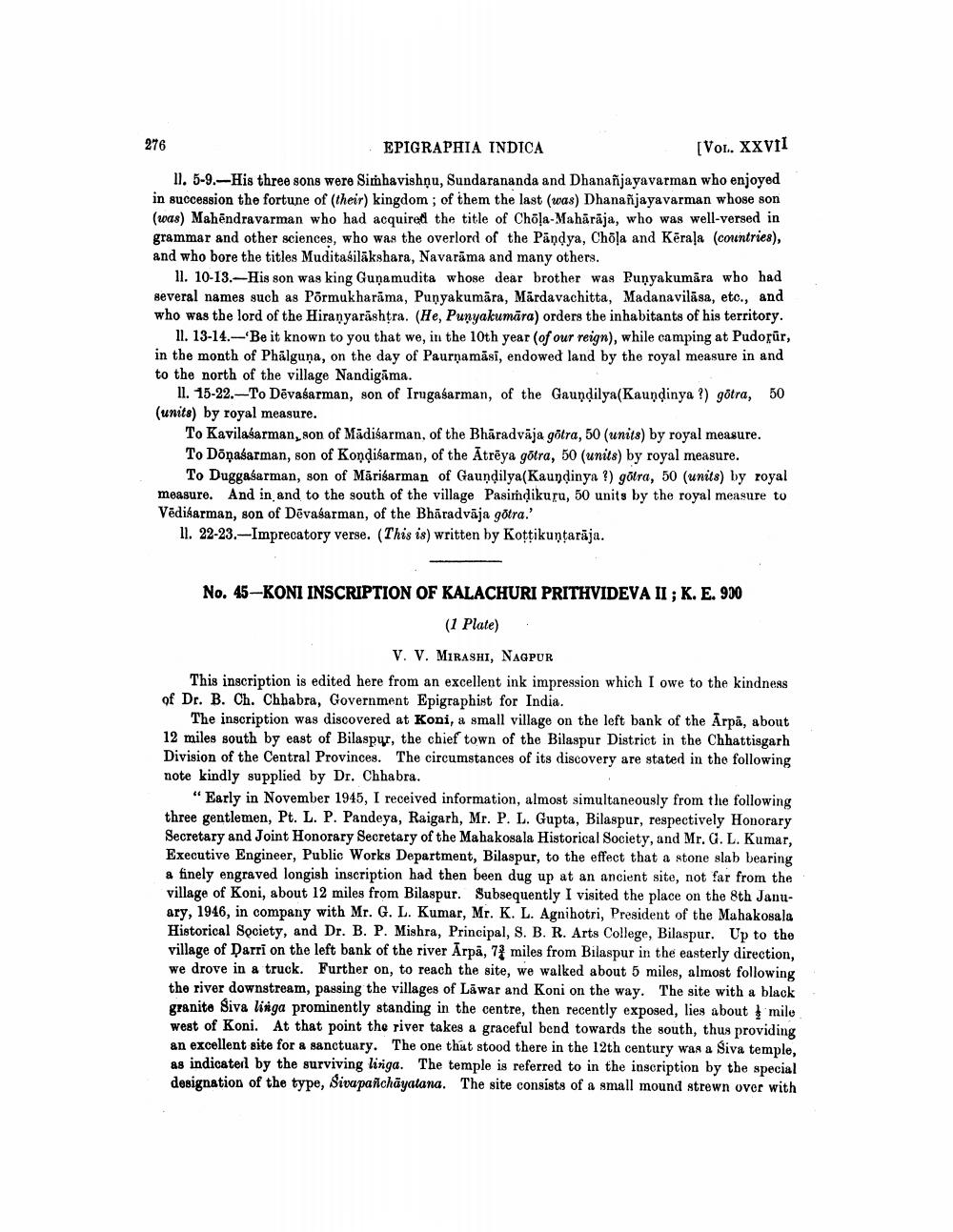________________
276
EPIGRAPHIA INDICA
[Vol. XXVII
11. 5-9.- His three sons were Simhavishņu, Sundarananda and Dhananjayavarman who enjoyed in succession the fortune of (their) kingdom ; of them the last (was) Dhananjayavarman whose son (was) Mahendravarman who had acquired the title of Chöļa-Maharaja, who was well-versed in grammar and other sciences, who was the overlord of the Pandya, Chola and Kerala (countries), and who bore the titles Muditasilākshara, Navarama and many others.
11. 10-13.-His son was king Gunamudita whose dear brother was Punyakumara who had several names such as Põrmukharāma, Punyakumāra, Mārdavachitta, Madanavilasa, etc., and who was the lord of the Hiranyarashtra. (He, Punyakumāra) orders the inhabitants of his territory.
11. 13-14. --Be it known to you that we, in the 10th year (of our reign), while camping at Pudorür, in the month of Phälguna, on the day of Paurņamāsi, endowed land by the royal measure in and to the north of the village Nandigama.
11. 15-22.-To Dēvasarman, son of Irugasarman, of the Gaundilya(Kaundinya ?) götra, 50 (units) by royal measure.
To Kavilasarman, son of Madisarman, of the Bhāradvāja götra, 50 (units) by royal measure. To Donaśarman, son of Kondisarman, of the Ātrēya götra, 50 (units) by royal measure.
To Duggasarman, son of Mārisarman of Gaundilya(Kaundinya ?) götra, 50 (units) by royal measure. And in and to the south of the village Pasimạikuru, 50 units by the royal measure to Vēdisarman, son of Dēvasarman, of the Bhāradvāja gotra.'
11. 22-23.-Imprecatory verse. (This is) written by Kottikuntarāja.
No. 45-KONI INSCRIPTION OF KALACHURI PRITHVIDEVA II ; K. E. 900
(1 Plate)
V. V. MIRASHI, NAGPUR This inscription is edited here from an excellent ink impression which I owe to the kindness of Dr. B. Ch. Chhabra, Government Epigraphist for India.
The inscription was discovered at Koni, a small village on the left bank of the Arpā, about 12 miles south by east of Bilaspur, the chief town of the Bilaspur District in the Chhattisgarh Division of the Central Provinces. The circumstances of its discovery are stated in the following note kindly supplied by Dr. Chhabra.
"Early in November 1945, I received information, almost simultaneously from the following three gentlemen, Pt. L. P. Pandeya, Raigarh, Mr. P. L. Gupta, Bilaspur, respectively Honorary Secretary and Joint Honorary Secretary of the Mahakosala Historical Society, and Mr. G. L. Kumar, Executive Engineer, Public Works Department, Bilaspur, to the effect that a stone slab bearing & finely engraved longish inscription had then been dug up at an ancient site, not far from the village of Koni, about 12 miles from Bilaspur. Subsequently I visited the place on the 8th January, 1946, in company with Mr. G. L. Kumar, Mr. K. L. Agnihotri, President of the Mahakosala Historical Society, and Dr. B. P. Mishra, Principal, S. B. R. Arts College, Bilaspur. Up to the village of Darri on the left bank of the river Arpa, 74 miles from Bilaspur in the easterly direction, we drove in a truck. Further on, to reach the site, we walked about 5 miles, almost following the river downstream, passing the villages of Lāwar and Koni on the way. The site with a black granito Siva linga prominently standing in the centre, then recently exposed, lies about milo west of Koni. At that point the river takes a graceful bend towards the south, thus providing an excellent site for a sanctuary. The one that stood there in the 12th century was a Siva temple, as indicateil by the surviving liriga. The temple is referred to in the inscription by the special designation of the type, Sivaparichayatana. The site consists of a small mound strewn over with




